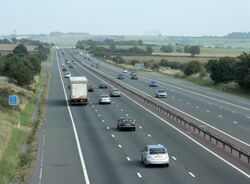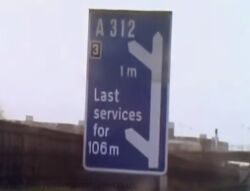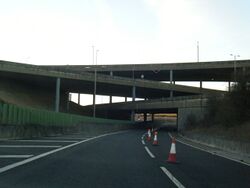Unbuilt Services On The M4
For a list of current service areas on the M4, see Services on the M4.
When the first few motorways were planned, their service stations were all very well organised. It all went wrong with the M4.
Part of the problem was that the M4 was developed in two separate sections: between London and Maidenhead, and broadly between Bristol and Newport. These two sections had their service areas neatly organised, as you might expect. They were:
- SA32: Heston (J2-3)
- Datchet (J5-6)
- (gap where the road hadn't been built)
- SA30: Pucklechurch (J18-19)
- SA29: Aust (J21)
- SA28: Wilcrick (J23-24)
At the eastern end, locating service areas was difficult because the road had closely-spaced junctions and a lot of neighbours. There was pressure from the police to ensure it had service areas before London. The chosen sites were slightly too close together, but otherwise did the job.
At the western end, it was clear that a service area would be needed somewhere near the Severn Bridge. A tour of possible sites, including Crick and Tormarton, took place in March 1962. Aust was decided to be the best location, and others were measured around it.
Heston and Aust were both treated as premier sites and were built first, with Datchet, Pucklechurch and Wilcrick to be built when traffic levels rose. Things would soon get very complicated - but first let's look at those three.
Datchet
The eastern end of the M4 was built in very short sections, based on a route which had been decided decades previously. Datchet was added to the plan just as this part of the M4 was about to open.
Five broadly feasible locations had been found between J5 and J6. A report to the Buckinghamshire county surveyor recommended choosing one of each, with the two facilities split to fit around the houses and the reservoir.
Datchet briefly looked like it would be prioritised over Heston, but Datchet would soon turn out to have even more issues. It was to be built on green belt land, and would encroach on Upton Park, as well as on land where a development had recently been refused. Objections were received from Buckinghamshire County Council, Slough Borough Council, Eton Rural District Council, Datchet Parish Council, Slough Civic Society and Datchet Residents Association.
The Ministry insisted it was the only suitable site in this area. Heston would take priority because it would be easier to deliver, so the Datchet plan was going to be held in reserve, but other issues would need to take priority.
Pucklechurch

The Pucklechurch site (SA30; J18-19) had all four ghost slips built. The 16 acre site was purchased by the Ministry of Transport, and held in reserve with no immediate plans to use it.
In the 1960s there were talks about the Bristol East Loop Road meeting the M4 at a new junction "near Pucklechurch, close to J18". It's not unheard of for planned service area sites to have been considered for other uses too. This proposed road has been suggested multiple times since.
In 1994 the Department of Transport explained that the ownership of the land was disputed. They advised that they understood the land wasn't being used, and that it was theirs to sell. Recent maps show that the land is not owned by England's national highway authority, but they do own two long drainage ditches which run down the farm access.
Wilcrick
Working west from Aust, the next site was ordered to be built "near Coldra". This would be (SA29; J23-24), with an 11 acre site found at Church Farm.
Like Pucklechurch, it has four ghost slips, but no evidence of any land being purchased. Those four slip roads were impacted when the M4 was widened in the 1990s, and in the 2000s their condition deteriorated fast.
With hindsight the location is far too close to M4 J23A, and would probably have been dangerous with modern traffic levels.
M4 Extensions
One document for Datchet said that the next service area to the west would be after The Thicket, but the M4 wasn't extended along that route. Instead, the confirmed route, which was announced in 1968, showed that the next major service area would be at Warren Copse.
The Warren Copse services plan was hugely unpopular at the public inquiry. Berkshire County Council claimed it would ruin the area's natural beauty, that the chosen site was a haven for wildlife and that it was too close to the village of Shurlock Row. The subject was debated in Prime Minister's Questions.
The Ministry of Transport conceded that there were "technical problems", and decided that no service area would be built with the new road. Plans for new service areas would be pursued separately. This made it very difficult to plan the remaining service areas on this section, because there was nothing to measure the distance to.

Thanks to the Warren Copse problem, a detailed plan for the rest of the M4 could never be put together. Work on the M4 was going ahead regardless, causing a sign to be erected on the M4 advising that Heston was the last service area "for 106 miles". Additional signs provided directions to fuel facilities in Reading town.
That said, we have seen a draft line-up, with potential service area locations marked out at broadly even intervals. Many of these did not progress very far, but the broad idea was as follows:
- Datchet (J5-6)
- Warren Copse (J8/9-10)
- Theale (near J12)
- Winterbourne (J13-14); Hermitage was also looked at
- Ridgeway (J14-15)
- Ballard's Ash (J16-17)
- Leigh Delamere (J17-18)
- This would join up with the site being held in reserve at Pucklechurch.
Ministry of Transport MSA Board, 1969
As always, the idea was that every-other site would be developed at first. Warren Copse and Leigh Delamere would be progressed immediately, while Ridgeway was revised to Membury and that one was pushed through too.
The decision to move Ridgeway is probably the reason that we never heard anything about Ballard's Ash or Winterbourne ever again. At Theale, a site at Ashes Copse was the subject of a ministry inquiry in 1969, but progress couldn't be made until it was known what was happening at Warren Copse. Alternative sites around Theale were also examined.
Warren Copse Saga
The failed Warren Copse plan of 1968 involved a 34 acre site with single-storey buildings. There would have been a footbridge provided as part of the road construction. It was set to go ahead, but legal issues meant it wasn't tied to the motorway's construction, creating a whole world of issues.
Berkshire County Council suggested the service area be built on Upperwood Farm near Earley instead. The Ministry were happy to go with this, and suggested it have single-storey buildings, a pedestrian footbridge and rear access to Cutbush Lane. The building 'Rushy Mead' would have had to be demolished. It was expected to open in December 1972, and needed negotiation with the University of Reading.
While the Ministry started work on the planning for Earley services, in 1974 the local government restructure brought about a new Berkshire County Council. The new council formally withdrew their support for Earley and argued that there was no need for any more services between the ones which had already been built at Heston and Membury (a gap of 55 miles). They did recommend another site at Field Farm - which is where Reading services was eventually built - but this time the council advised that they wouldn't be supporting it.
A joint public inquiry was then held, which aimed to decide between Warren Copse and Earley. Environmental concerns caused both proposals to be dropped. It was later stated that "opposition" was the problem at Earley.
Throughout the 1980s the Department of Transport continued to insist they were looking at a possible service area "in the Reading area". This eventually led to Reading services being built.
When the M25 was opened in 1985, the issue of the lack of services between Reading and Heston (and onwards along the M25) became an issue again. A number of private developers made proposals for new services in the Maidenhead area, which resulted in lengthy public inquiries in 1999 and 2002. These concluded that there was a problem, but that the best place to resolve it was on the M25.
Different in Wales
The Welsh Office became responsible for motorway planning in Wales in 1964. They didn't really have the resources to set up a planning and tendering system like the Ministry of Transport had been using, so instead they decided to let individual firms decide for themselves where the service areas would be built.
This led to a large number of rival service areas being built close together, all being built in offline locations. There was no strategy to link them up, but such a strategy wasn't really needed because open competition was working well on this particular road. The first developer collapsed before their service area was finished, leading to initial concern that this idea wasn't going to work.
This same policy was adopted by the Department for Transport in England in 1992. They had previously quipped, "[The Welsh] like to do their own thing with that little motorway of theirs", but when the English system was changed they said that they were inspired by the success of the Welsh system. The Welsh Office had already described their policy as "very successful".
Private Proposals

In Wales, and since 1992 in England, developers have been solely responsible for coming up with their own proposals for new motorway services. This led to an increase in proposals, but they are normally clustered around the same area and most are quickly ruled out.
Some of the new motorway services once planned for the M4 we have uncovered include:
| Place | Location | Proposed | Resolved | Outcome | Notes |
|---|---|---|---|---|---|
| Almondsbury | J19 (west side) | 1960 | 1960 | Withdrawn. | This was only a proposal, but it is interesting. Motorway Services Ltd advised that they were considering purchasing this land, and that they wanted the motorway junction to accommodate it. They were told it was technically impossible and against the regulations. |
| Sarn Park | J36 (north-west corner) | 1979 | 1986 | Built. | Initial developer collapsed, leading to criticism of the decision to allow private developers. |
| Capel Llanilterne | J33 (south-east corner) | 1981 | 1981 | Refused. | Planned by Wimpey Construction Ltd. |
| Cardiff West | J33 (north side) | 1981 | 1990 | Built. | Planned by A. Monk & Co. Dev. (SW) Ltd. |
| Newport | J28 | 1982 | 1982 | Withdrawn. | Planned by West Park (Porthcawl) Ltd. |
| Pont Abraham | J49 (west side) | 1982 | 1983 | Built. | Planned by BP. |
| Swansea West | J47 (north side) | 1982 | 1991 | Built. | Planned by Llewellyn Developments. |
| Chieveley | J13 (south-east corner) | 1986 | 1986 | Signed. | Was built to serve the A34, but some signs were placed on the M4 anyway. |
| Cardiff Gate | J33 (south side) | 1988 | 2000 | Built. | Planned by Heron Homes and Brunswick IDL. |
| Magor | J23A (north side) | 1987 | 1992 | Built. | Planned by Granada/Esso and Whitbread/BP. |
| Reading | J12-13 | 1987 | 1995 | Built. | Originally a Department of Transport plan, then Mobil. |
| Castleton | J29 (south-west corner) | 1990 | 1992 | Refused. | Objected to by Cardiff Borough Council who wanted to develop J30. |
| Wilcrick | J23A-24 | 1991 | 1992 | Refused. | |
| Wootton Bassett (Hook) | J16-17 (Ballards Ash) | 1994 | 1995 | Refused. | Planned by Roadchef and Messrs A & L Basson; Tucker Parry Knowles and Extra. |
| Pucklechurch | J18-19 (west of Burbarrow Lane) | 1994 | 1996 | Refused on appeal. | Planned by Granada/Boulevard Land Ltd. East of and larger than the previous reserved site. Timing is related to Severn View becoming redundant. Opposed by Campaign to Protect Rural England and Sir David Puttnam. |
| Lyde Green | J18-19 (east of Coxgrove Hill) | 1994 | 1996 | Refused. | Planned by J H Higgins and Total. Temporary site layout designed to accommodate M4 J18A - refused because it interfered with that plan. |
| Maidenhead (Holyport) | J8/9 (south side) | 1994 | 2003 | Refused on appeal. | Planned by Granada with Boulevard Land Ltd. Thrown out at public inquiry. A 'westbound only' and an 'all-moves' version of the plan were both produced. Featured in 1999 and 2002 public inquiries; refused because it's green belt land and would do "substantial harm". Opposed by M4 MSA Action Group. |
| Great Hazes | J8/9-10 (near Mare Lane) | 1995 | 2003 | Refused on appeal. | Eastbound side only. Planned by Hallam Land Management and Avalon Enterprises. Taken to 1999 and 2002 public inquiries; refused because it's green belt land. Opposed by M4 MSA Action Group. |
| Maidenhead (Braywick) | J8/9 (north-east side) | 1995 | 2000 | Refused on appeal. | Planned by Stansford Holdings Ltd. |
| Great Wood | J8/9-10 (near Howe Lane) | 1996 | 2003 | Refused on appeal. | Planned by Extra with Roadchef, later just Extra. One version was for westbound traffic only, a second version had an underpass and loop to allow both directions to access it. The underpass was removed because it would have been too difficult to build here. Featured in 1999 and 2002 public inquiries; refused because it's green belt land. Opposed by M4 MSA Action Group. |
| Margram (Port Talbot) | J37-38 (by Eglwys Nunydd Reservoir) | 1980, 1999 | 2003 | Withdrawn. | 1999 plan came from Welsh Development Agency. |
| Bridgend | J37 (south-west corner) | 2022 | ongoing | A plan by Draycott Group and McDonald's has been widely referred to as a motorway service area, but with only fuel and drive thus, it's unlikely to qualify as one, and isn't even easy to get to from the M4. Local authority are so far unconvinced that the M4 needs more service areas. | |
| Swindon | J16 (south-east corner) | 2023 | ongoing | Planned by Moto. |